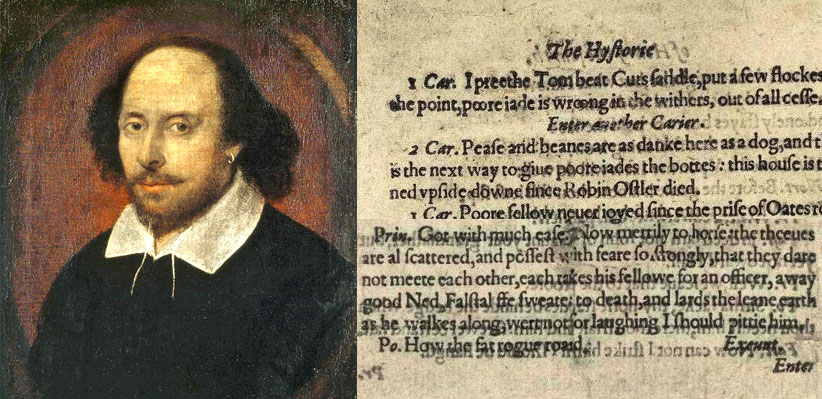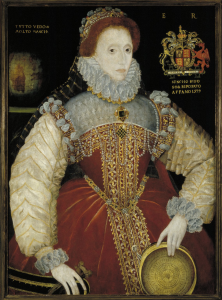 In honor of William Shakespeare we are celebrating the 400th anniversary of his death on April 23, 2016. What better way to do this, than by highlighting the writing done by first-year students in Associate Professor of English John Wesley’s first-year seminar, A Year in the Life of William Shakespeare? This first-year seminar in scholarly inquiry studies four remarkable plays Shakespeare wrote or saw into production in 1599, the same year he opened the Globe Theatre. In the first half of the course, students were introduced to the myriad ways in which Shakespeare’s 1599 plays are shaped by and give shape to the political and cultural intrigues of that year. In the second half of the course, students turned to a play (and year) of their own choosing, the historicist analysis of which is the basis of an independent research project. As part of this project, students were asked to prepare a blog post that reflected on aspects of Shakespeare’s life, a specific work, or a resource or organization associated with Shakespeare, or to provide a personal interpretation of a play. During the month of April, we’ll feature the posts from students that celebrate all things Shakespeare!
In honor of William Shakespeare we are celebrating the 400th anniversary of his death on April 23, 2016. What better way to do this, than by highlighting the writing done by first-year students in Associate Professor of English John Wesley’s first-year seminar, A Year in the Life of William Shakespeare? This first-year seminar in scholarly inquiry studies four remarkable plays Shakespeare wrote or saw into production in 1599, the same year he opened the Globe Theatre. In the first half of the course, students were introduced to the myriad ways in which Shakespeare’s 1599 plays are shaped by and give shape to the political and cultural intrigues of that year. In the second half of the course, students turned to a play (and year) of their own choosing, the historicist analysis of which is the basis of an independent research project. As part of this project, students were asked to prepare a blog post that reflected on aspects of Shakespeare’s life, a specific work, or a resource or organization associated with Shakespeare, or to provide a personal interpretation of a play. During the month of April, we’ll feature the posts from students that celebrate all things Shakespeare!
Congratulations to our wonderful first-year writers. For additional online resources about Shakespeare, check out these sites:
- British Library: http://www.bl.uk/
- Folger Shakespeare Library: http://www.folger.edu/
- Globe Theatre: http://www.shakespearesglobe.com
- Internet Shakespeare Editions: http://internetshakespeare.uvic.ca
- Shakespeare 400: http://www.shakespeare400.org/
Shakespeare’s Influences and Influencers
By Keely Coxwell
On the four hundredth anniversary of William Shakespeare’s death we celebrate not only his life but what he created as well. In fifty-eight years William Shakespeare wrote thirty seven plays and one hundred and fifty four sonnets. According to Marvin Spevack’s concordances, that is 884,647 words and 118,406 lines and 1,224 characters (“Shakespeare FAQ.”). Not only are these numbers mind boggling but they attest to Shakespeare’s ability and creativity. That is 1,224 characters with different personalities and thirty seven unique stories. When I saw those numbers I questioned how one man could possibly come up with all of those stories but, of course, Shakespeare didn’t just pull some of these ideas out of thin air. Thorough out his plays, scenarios and characters were influenced by things such as the political climate, events, and other people.
The connection to Queen Elizabeth and Julius Caesar would have been fairly obvious to contemporary Elizabethans at the time. During the time Julius Caesar was written Elizabeth was criticized as being weak and feeble Shakespeare then made his Julius Caesar to be as week and feeble, like Elizabeth (Shapiro, 151-152). If this didn’t aspect of Julius Caesar didn’t bring Elizabeth to mind the fact that she often compared her self to Julius Caesar would. Also, Julius Caesar was very much a warning tale. There had been multiple attempts on Elizabeth’s life and Julius Caesar depicted the chaos that follows an assassination.(Shapiro, 144-145). Not only did Elizabeth influence characters but she might have been the reason why Merry Wives of Windsor was written. It’s rumored that Shakespeare wrote Merry Wives of Windsor because after seeing Henry IV, Part Two Queen Elizabeth wanted to see more of Falstaff; specifically, Falstaff in love (Herman).
It wasn’t just political figures who influenced Shakespeare’s writing, one of the main reasons Shakespeare wrote such strong female characters in As You Like It was because two good boy actors had recently joined his company (Shapiro, 114). Elizabeth wasn’t the only person who shaped a character in one of Shakespeare’s plays. The Earl of Essex greatly influenced the character Henry V in the play of the same name. The Earl of Essex was for the war with Ireland, he even used what Henry V did (in real life and in the play) to justify his reasonings. Similarly to Julius Caesar the people watching the play would have recognized this connection.
Shakespeare started Hamlet with jittery soldiers guarding Denmark which referenced the soldiers that were in London in response of the threat of the Spanish Armada invading in 1599 (Shapiro, 187). Similarly Henry V, was heavily influenced by England’s war with Ireland. The debate over the merits of and simply whether or not to go to war in Henry V would have felt almost too real for the contemporary Elizabethans watching the play (Shapiro, 79-82).
We might not have a story about Julius Caesar if Elizabeth I wasn’t the queen she was and the debate in Henry V might have felt every different if it were not for the war with Ireland.
Bibliography
Elizabeth I, the Plimpton Sieve Portrait. ca. 1540–1596. Folger. Folger Shakespeare Library. Web. 1 Mar. 2016. <http://www.folger.edu/works-of-art>.
Herman, Jan. “A Not-So-Merry ‘Wives of Windsor’.” Los Angeles Times 22 June . Web. 1 Mar. 2016.
“Shakespeare FAQ.” Folger Shakespeare Library . N.p., n.d. Web. 1 Mar. 2016. <http://www.folger.edu/shakespeare-faq>.
Shapiro, James. A Year in the Life of William Shakespeare 1599. New York: Harper Perennial, 2005. 79-187. Print.
Ziegler, Georgianna. Elizabeth I: Then and Now. N.p.: Folger Shakespeare Library, 2003. N. pag. Web. 1 Mar. 2016.

